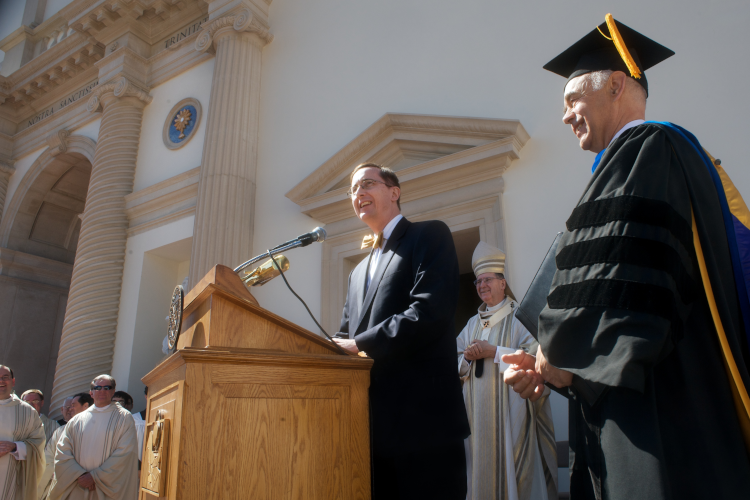
“Behind every great building and its architect there is a visionary patron. Someone who thinks big, takes risks, raises funds, and above all recognizes the significance of architecture.”
So writes Duncan G. Stroik, the design architect of Our Lady of the Most Holy Trinity Chapel, of Thomas E. Dillon, the building’s patron and the late president of Thomas Aquinas College. For nearly a decade, the two men worked closely on every detail of the Chapel. Together, this architect and his patron, blessed the Thomas Aquinas College with an extraordinarily beautiful House of God.
The Architect
A professor of Architecture at the University of Notre Dame and principal of Duncan G. Stroik Architect, LLC, a firm specializing in ecclesiastical design, Mr. Stroik’s architectural practice grows out of a commitment to the principles of classical architecture and urbanism. Throughout his career he has focused on the design of ecclesiastical, civic, and residential buildings which are well built, convenient, and beautiful. His education and work have closely paralleled the evolution of the international classical movement, and he has participated in the new renaissance of sacred architecture.
Mr. Stroik received his architectural education from the University of Virginia and Yale University. Following graduation, he served as a project designer for the architect Allan Greenberg, with whom he designed a number of prestigious civic, institutional, collegiate, and residential projects. In 1990 Mr. Stroik was invited to help form and implement a new curriculum in classical architecture at the University of Notre Dame, later hailed by the New York Times as the “Athens of the new movement.”
In addition to his work on Our Lady of the Most Holy Trinity Chapel, Mr. Stroik designed the Shrine of Our Lady of Guadalupe in La Crosse, Wis. His involvement in the new renaissance of sacred architecture has led to the formation of the Society for Catholic Liturgy and the Sacred Architecture Journal, of which he is editor.
Mr. Stroik has also organized conferences on sacred architecture, led seminars in Italy, and been featured on a number of television programs. He has designed projects for houses in New England, Chicago, and Ireland, and churches in California, Nebraska, Arizona, and Kentucky.
The Patron
In the Spring 2009 issue of Sacred Architecture Mr. Stroik observes that, as the patron of Our Lady of the Most Holy Trinity Chapel, Dr. Dillon was “an incredibly busy man, but he found time to do the things that mattered, such as visiting artists’ workshops and traveling to Europe to pick out marble.”
Adds Mr. Stroik, “[Dr. Dillon] was deeply engaged in the design and construction process and thought of the church like it was his own, like a book that people would read for centuries to come. Involvement in every aesthetic detail came naturally to him because he believed that the domus Dei needed to be worthy of the Creator. This drive for excellence meant that he wanted to be convinced through words, drawings and precedent that every design decision was correct.”
Mr. Stroik and Dr. Dillon worked “in the spirit of coauthors,” he says, and the myriad artistic and iconographic elements that define this crown jewel of the Thomas Aquinas College campus “all flowed from [Dr. Dillon’s] vision for the church and his own character.”
It was fitting, then, that when Our Lady of the Most Holy Trinity Chapel was dedicated on March 7, 2009, Dr. Dillon was the first to proclaim the Word of God from its mahogany ambo. Quoting the prophet Ezra, he declared, “Today is holy to the Lord your God” (Neh. 8:9). How poignant it was that when Dr. Dillon was killed in an automobile accident less than six weeks later, his was the first funeral Mass offered in the Chapel.
Dr. Dillon’s faithful leadership, his sacrificial efforts on the College’s behalf, and his tremendous love of God are now memorialized in the sacred building he labored to make a reality. The College remains forever grateful for his life and his presidency, praying for him daily in this, his final gift to the community he faithfully served.







